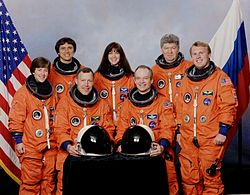STS-91
| Mission emblem | |||
|---|---|---|---|

|
|||
| Mission dates | |||
| Mission: | STS-91 | ||
| COSPAR-ID : | 1998-034A | ||
| Crew: | 7th | ||
| Begin: | June 2, 1998, 22:06:24 UTC | ||
| Starting place: | Kennedy Space Center , LC-39A | ||
| Space station: | Me | ||
| Coupling: | June 4, 1998, 16:58 UTC | ||
| Decoupling: | June 8, 1998, 16:01 UTC | ||
| Duration on me: | 3d 23h 3min | ||
| Landing: | June 12, 1998, 18:00:24 UTC | ||
| Landing place: | Kennedy Space Center, Lane 15 | ||
| Flight duration: | 9d 19h 54min 2s | ||
| Earth orbits: | 155 | ||
| Rotation time : | 91.1 min | ||
| Apogee : | 330 km | ||
| Perigee : | 326 km | ||
| Covered track: | 6.0 million km | ||
| Team photo | |||
 v. l. No. Wendy Lawrence, Franklin Chang-Diaz, Dominic Pudwill Gorie, Janet Kavandi, Charles Precourt, Valeri Ryumin, Andrew Thomas |
|||
| ◄ Before / After ► | |||
|
|||
STS-91 ( english S pace T ransportation S ystem) is the mission designation for a flight of the US Space Shuttle Discovery ( OV -103) of NASA . The launch took place on June 2, 1998. It was the 91st space shuttle mission, the 24th flight of the space shuttle Discovery, the eleventh and last flight as part of the Shuttle Mir program and the ninth and final coupling of a US Space shuttle to the Mir space station .
team
- Charles Precourt (4th space flight), commander
- Dominic Gorie (1st space flight), pilot
- Wendy Lawrence (3rd spaceflight), mission specialist
- Franklin Chang-Diaz (6th spaceflight), mission specialist
- Janet Kavandi (1st spaceflight), mission specialist
-
Valeri Ryumin (4th space flight), mission specialist ( Roskosmos / Russia )

Me crew return flight
- Andrew Thomas (2nd space flight)
(Returned to Earth after a flight time of 140 days, 15 hours and 12 minutes; one-way flight on STS-89 )
Mission description
During the last flight of a US shuttle to the Russian Mir space station , the focus was again on material transport. Andrew Thomas, the seventh astronaut who lived and worked on board a Russian space station, was also picked up. With it, many scientific samples and some apparatus were also brought back to Earth, including a system for measuring minimal accelerations through the movements of space travelers on board (Space Acceleration Measurement System) and a cell culture experiment for observing the long-term development of certain cell types in weightlessness ( CoCulture). During the coupling phase on the Mir coupling module, air and water samples were also taken in order to determine the changes in the environmental conditions on board the station. After disconnecting from the Mir station, the Discovery looked for a green fluorescent gas that had been pumped into the damaged Spektr module . The aim was to find out exactly where the leaks were.
Important scientific payloads on board the Discovery were the Alpha Magnetic Spectrometer (AMS), a complex of devices for researching combustion processes in weightlessness (Solid Surface Combustion Experiment), and a new type of system that enables direct communication via telephone, satellite and Inmarsat stations. Fax and data transmission between the astronauts and scientists on earth should allow. However, due to technical difficulties, this system could not be used. Similar problems were also encountered with the space shuttle's Ku-band antenna , so that no television broadcasts were possible. In addition, the measured values of the AMS had to be largely recorded. The evaluation took place on earth, but did not provide evidence of antimatter in cosmic radiation. A total of around 3 million helium atoms were detected. But not a single anti-atom was found among them. In any case, the AMS was only tested during the Discovery mission. The long-term use of such a particle detector was realized on the International Space Station with AMS-2 . However, the experiment produced two astonishing results. There are four times as many positrons as electrons in near-Earth space . Until now it was assumed that these particles occur equally frequently. In addition, slow protons that originate from the sun are initially held in the magnetic field 2,000 kilometers around the equator for a long time before they fly to the poles.
The Space Vision System was used several times to facilitate working with the manipulator arm. Using several cameras and measuring points in the loading bay and at the tip of the robotic arm, a virtual image of the loading bay environment is generated in a laptop. Distances can be determined more precisely here than by looking out of the window. The object of observation was initially the outer skin of some modules of the Mir space station, later a leak in a water tank of the energy system.
For the first time, a space shuttle took off with a new main tank (Super Lightweight External Tank) made of an aluminum - lithium alloy. Thanks to the honeycomb structure of its surface, it is lighter, but about 30% more stable than the previous model. In addition, the maximum useful weight of the space transportation system can be increased by around 3.5 tons. The Discovery landed in Florida on schedule.
See also
Web links
- NASA Mission overview (English)
- Video summary with comments of the crew (English)
- NASA video of Mission (English)

